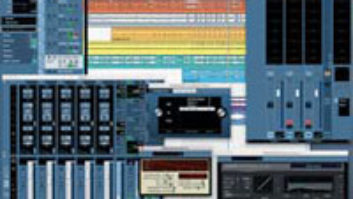
Project5 is the new synth/sampler/drum machine-in-a-virtual-rackapplication from Cakewalk. This is not a new idea, but Project5 isdifferent from many of its predecessors and more sophisticated in anumber of ways. The key distinction is its ability to handle DXi andVST synthesizers and signal processing, plus ReWire support. Whilethere are a number of nice VST and DX hosts available, it’s helpful tohave everything integrated into a tidy package.

UNDER THE HOOD
Project5 features the P-SEQ sequencer. Though it’s not a super-deepworld-class sequencer, it definitely does the trick. The maximumresolution is a 128th-note triplet, which should be sufficient for mostelectronic music, the primary intention of this product. Inputs cancome in the form of pre-existing patterns (from the Pattern Bin) orfrom an external MIDI controller. MIDI input can be live and in realtime; step sequencing is available, as well. P-SEQ can be used tocreate patterns that are then “sent” to the Tracker, themain area where the song’s layout is displayed. The Tracker shows two“panes”: Track and Arrangement. The Track pane displays alist of the various instruments used in the song and information aboutthem. The Arrangement pane is where the patterns that form the song areedited and arranged. P-SEQ also enables automation of quite a number ofparameters.
SYN.OPS — “synthesizer operations” — is awindow that enables the instrument output to be sent to any of fourauxiliaries. It’s also where the various parameters of the instrumentsare controlled. There is also an analog-style step sequencer known as“Synchron 32” that is used as a MIDI plug-in. Once apattern is entered into Synchron 32, it can be triggered by events inTracker; synchronization is automatically maintained.
The Cyclone DXi is essentially a loop player. It can accept ACIDizedor .WAV files, and behaves similarly to Propellerhead’s ReCycle. Loopscan be broken into constituent “slices,” and each slice canbe altered individually in terms of level, pan and pitch.
The DS864 Sampler yields a lot of power. All of the typical samplerfeatures are there, including key mapping and diverse velocity zonesfor rich piano patches or realistic percussion. Looping is supported,and volume offsets, tuning and panning are adjustable, as well. Thereare some basic effects available — like wave reversal, phaseinversion and bit decimation — to emulate vintage low-resolutionsamplers. Separate envelope generators are provided for each of the twofilters: pitch and amplitude. Lowpass, highpass, bandpass and notchfilters are available in filter 1, while filter 2 is a lowpass; bothfilters are resonant. There are also three LFOs with five differentwaveforms that can be routed to many parameters. Another nice touch isthe Portamento sample that handles quite a number of formats, including.WAV and .AIFF, .AKP (Akai), .KRZ (Kurzweil), .SF2 and DS864’sproprietary format, .DP8.
According to Cakewalk’s manual, the nPULSE Modular Drum Synth is“reminiscent of Roland’s TR808.” Indeed, this virtual drummachine offers 12 voices, each of which is essentially a subtractivesynthesizer. The module can be key-mapped for easy MIDI play, andoffers ring and frequency modulation between certain voices. Thesevoices go beyond just oscillator/filter/envelope. The kicks and tomshave a Drive parameter that imparts some color to the sound. Each voicecan be routed to any of five distinct outputs.
Project5 also provides the PSYN Virtual Analog Synthesizer. This isa very respectable, 64-voice polyphonic synth featuring fouroscillators. Each can deliver sine, triangle, pulse, up saw, down saw,noise or virtually any combination thereof. There is also asuboscillator that renders a sine wave an octave below the mainoscillator. Ring modulation and FM synthesis are available, as well.There are two filters: The first is a 2-pole that can be configured aslowpass, highpass, bandpass and notch; the second is a 4-pole lowpassthat is intended, according to the manual, to emulate the“traditional Moog filter of the 1960s.” Both filters areresonant. It’s nice that the filters can be inserted in series orparallel, because it adds a lot of flexibility. There are five envelopegenerators with attack, decay, sustain, slope and release. As with theDS864 Sampler, there is also a Delay parameter that Cakewalk claims isa sixth stage of the envelope, but it simply delays the onset of theattack and gives no control over the envelope’s dynamics. On the otherhand, it’s quite nice to be able to delay the onset of an envelope thatcontrols a filter or VCA, or delay the onset of another voice when thepatch uses layered oscillators. There are three LFOs available,essentially with the same features as those in the DS864 Sampler.
If nPULSE’s electro drums are not working for your acousticalproject, then Velocity Drum Sampler is available. This is similar toNative Instrument’s Battery (although not as deep) or LM-4 fromSteinberg. (Incidentally, Project5 supports LM-4 samples.) You have abank of 18 samples set up for triggering via MIDI. To emulate vintagesamplers, each sample can be changed in terms of pitch, reversing,start or end offset, looping and bit decimation. There are envelopegenerators for amplitude and pitch and a resonant lowpass filter. Thereis also a “choke group” that stops sample playback when anyother sample in the group is played.
IN ACTION
I opened up a few of the included sample sequences to get a feel forthe operation of Project5 and found the interface reasonablyaccommodating. This is not the only“rack-full-of-virtual-modules”-type application thatsuffers from the difficulty of having a lot of features to squeeze ontothe screen simultaneously. Still, I was able to navigate freely throughthe features. Most of the interface is self-explanatory, with thetypical Save, Open and Browse icons that do exactly what you think theydo. I was able to play sequences both via MIDI controller and also byliterally dragging notes into the pattern sequencer. Loops and otherchunks of audio are loaded from and saved to disk via menu dialog, andI was able to create automation of much more than level and panningvery easily in the P-SEQ, as well. The interface is visually appealing,but the signal processors in the mix panel lack the photo-realisticsheen of other such products. The knobs are easily “grabbed andturned,” even with my rotten little track pad!
CONCLUSION
Project5 is a robust environment for the creation of electronicmusic. Among its higher points are the ReWire support, analogsynthesizer and the ability to use VST and DXi plug-ins. Once again,while there are plenty of VST/DXi hosts to choose from, it’s nice tohave all of the sequencing, mixing and automation capabilitiesintegrated together. The idea behind Project5 is not new, but this is aunique and useful application.
Cakewalk, 888/225-3925, www.cakewalk.com.
John McJunkin is the principal of Avalon Audio Services inPhoenix.


Project5 offers instruments and effects, pattern-basedsequencers and processors, ACID(tm)-compatible audio looping tools,real-time, live-performance features and more.

The PSEQ module

The PSYN virtual analog synth

The DS864 sampler
Want to try Project5? Download a trial here.

